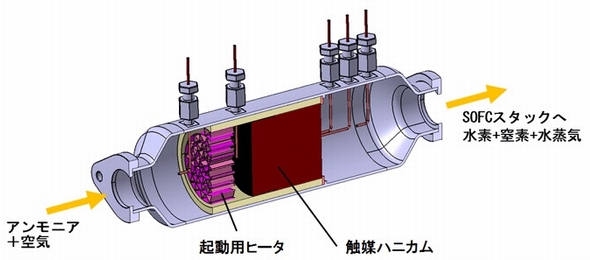Development of Direct Ammonia Fuel Cells
By Trevor Brown on October 05, 2017
Ammonia Energy Anniversary Issue: a “top five” development in technology advancement
In the last 12 months …
Researchers from three continents have pushed the boundaries for direct ammonia fuel cells, setting records in power generation and continuous operation.
The new generation of fuel cells: fast, furious, and flexible
Investors look at what is proven, not what is possible. Until recently they assumed that ammonia fuel cells would use PEM technology and that ammonia fuel would need to be cracked into hydrogen before use. Those two assumptions define one route for ammonia energy (a very important one, marked by another of this year’s technology advancements: ammonia-to-hydrogen conversion technologies), but not the only route. This year saw a series of projects developing direct ammonia fuel cells, using SOFC and AEM technologies.
Researchers at the University of Perugia in Italy demonstrated that solid oxide fuel cell (SOFC) systems fueled with ammonia could be “more efficient than equivalent hydrogen-based” systems.
The US Department of Energy’s ARPA-E awarded funding under the REFUEL program for a pair of direct ammonia fuel cell projects. One aimed to “greatly reduce the cost of solid oxide fuel cells while providing a high-efficiency, long-life power generating option.” The other aimed to develop a hydroxide exchange membrane fuel cell that would operate at 100 °C (near-ambient conditions, relative to high-temperature SOFCs).
Perhaps this year’s biggest advance in this busy arena came from Japan, where researchers at Kyoto University achieved “the world’s largest power generation output of an NH3 fuel cell,” with efficiency in excess of 50% for 1,000 hours of continuous operation – the duration might be the most impressive aspect here.
According to Grigorii Soloveichik, program manager of REFUEL: “Ammonia fuel cell technology has the potential to be widely used in long term energy storage and the transportation sector (UAVs, range extenders, APUs). Fuel cells can convert ammonia, which can be easily stored in liquid form, to electricity with efficiencies higher than that using internal combustion engines (ICE). In addition, fuel cells, in contrast to ICE combustion processes, do not produce NOx pollutants. A variety of fuel cell technologies from low temperature AEM to high temperature SOFC could be used for this purpose.”

Looking to the future, many of these projects will be presenting updates at the NH3 Fuel Conference as part of the AIChE Annual Meeting this November. These include the University of Delaware, funded through ARPA-E’s REFUEL program, Kyoto University and its industrial consortium, and also Haldor Topsoe, one of the conference sponsors. Well known as a licensor of ammonia synthesis technology, Haldor-Topsoe will present “experimental results from … power production from ammonia using Solid Oxide Cell.” You can find their conference abstracts at the links above.
Ammonia Energy reporting
- July 2017: Ammonia-Fueled Solid Oxide Fuel Cell Advance at Kyoto University
- April 2017: The new generation of fuel cells: fast, furious, and flexible
- December 2016: REFUEL Ammonia Use-Side Funding Awards
- October 2016: Ammonia Fuel Cells: SOFC stack test and system analysis
A year in review
To mark the first anniversary of Ammonia Energy, we reviewed the most important developments from the last 12 months. This “top ten” list spans two areas: five are technology advances that will arguably produce the most important opportunities for ammonia energy, and five are economic implementation steps that are arguably the most significant moves toward real-world deployment.
Technology advancement:
- The Dawn of Bio-Ammonia
- Advances in Ammonia-Fired Gas Turbines Open Up Major Use Case
- Overcoming the Selectivity Challenge in Electrochemical Ammonia Synthesis
- Progress toward Ammonia-to-Hydrogen Conversion at H2 Fueling Stations
- Development of Direct Ammonia Fuel Cells
Economic implementation:
- Yara’s Solar Ammonia Plant is a Key Step toward Global Trade in Renewable Energy
- Power-to-Ammonia: the Economic Viability of Ammonia Energy
- Green Ammonia Consortium: Bright Prospects in Japan for Ammonia as an Energy Carrier
- The Maritime Industry Begins Assessment of Ammonia as a Fuel
- Ammonia Energy Gains Recognition from U.S. Department of Energy